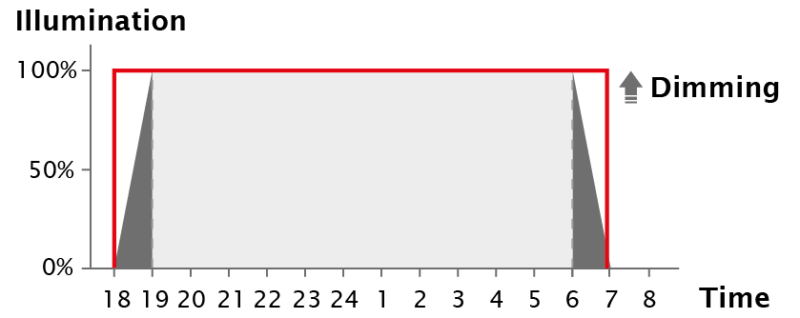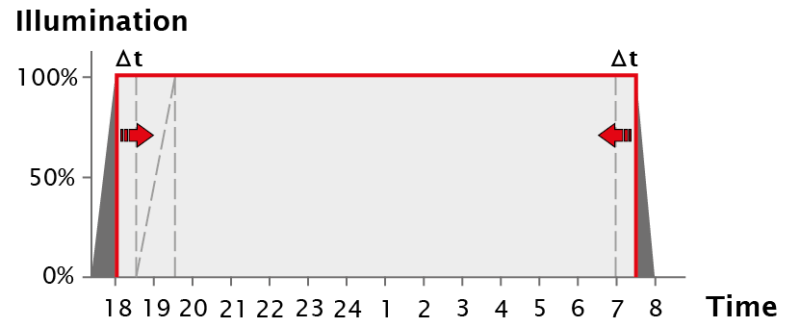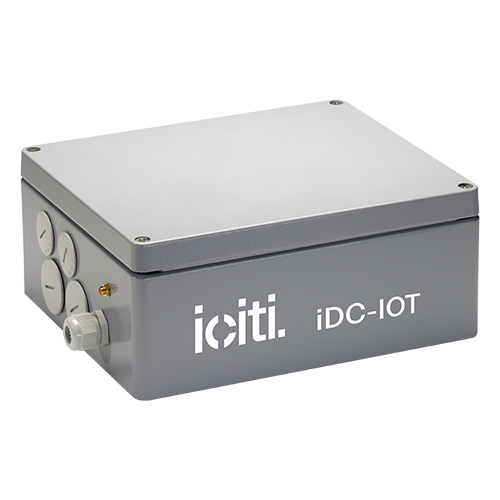iPC
Intelligent Luminaire Controller (Pole built-in)
Intelligent Luminaire Controller (Pole built-in)
Developed for use in street lighting and lighting in the vicinity of buildings, the interoperable iPC controls electronic operating devices fitted with a 1–10 V, PWM or DALI interface via standardised powerline communication in the C/B band according to CENELEC 50065-1 based on the OLC LonMark® profile.
Standardised data transmission is in accordance with ANSI/CTA and EN. Operation is possible in light management systems, in stand-alone, repeating or iMCU emulation mode.
Individually programmable and updateable, it performs all the tasks of a modern light management system and thus ensures a high degree of investment protection.
Further Advantages
- Luminaires can be switched off when connected to a switched lighting cable
- Power consumption: 1 to 3 W
- Adjustable control input to suit various tasks
- Connection of various sensors such as motion sensors, key switches and light sensors
- 10 time-dependent, synchronisable dimming levels with individual dimming sequences can be set via control line or the control input in stand-alone mode
- Lighting can be switched on earlier and switched off with a delay with individual dimming sequences
- Compensation of reduction in luminous flux with freely definable values for lamp service life as well as start and end levels
- Burning in of high-pressure discharge lamps after lamp replacement
- Optionally available with an audio frequency ripple control receiver to enable migration of existing systems
- 2 years warranty
Typical Applications
- Street lighting and lighting in the vicinity of buildings, parks
- Car parks, bus stops and railway stations
- Company premises, warehouses
- Sports facilities
Downloads
Developed for use in street lighting and lighting in the vicinity of buildings, the interoperable iPC controls electronic operating devices fitted with a 1–10 V, PWM or DALI interface via standardised powerline communication in the C/B band according to CENELEC 50065-1 based on the OLC LonMark® profile.
Standardised data transmission is in accordance with ANSI/CTA and EN. Operation is possible in light management systems, in stand-alone, repeating or iMCU emulation mode.
Individually programmable and updateable, it performs all the tasks of a modern light management system and thus ensures a high degree of investment protection.
Further Advantages
- Luminaires can be switched off when connected to a switched lighting cable
- Power consumption: 1 to 3 W
- Adjustable control input to suit various tasks
- Connection of various sensors such as motion sensors, key switches and light sensors
- 10 time-dependent, synchronisable dimming levels with individual dimming sequences can be set via control line or the control input in stand-alone mode
- Lighting can be switched on earlier and switched off with a delay with individual dimming sequences
- Compensation of reduction in luminous flux with freely definable values for lamp service life as well as start and end levels
- Burning in of high-pressure discharge lamps after lamp replacement
- Optionally available with an audio frequency ripple control receiver to enable migration of existing systems
- 2 years warranty
Typical Applications
- Street lighting and lighting in the vicinity of buildings, parks
- Car parks, bus stops and railway stations
- Company premises, warehouses
- Sports facilities
Downloads
Developed for use in street lighting and lighting in the vicinity of buildings, the interoperable iPC controls electronic operating devices fitted with a 1–10 V, PWM or DALI interface via standardised powerline communication in the C/B band according to CENELEC 50065-1 based on the OLC LonMark® profile.
Standardised data transmission is in accordance with ANSI/CTA and EN. Operation is possible in light management systems, in stand-alone, repeating or iMCU emulation mode.
Individually programmable and updateable, it performs all the tasks of a modern light management system and thus ensures a high degree of investment protection.
Further Advantages
- Luminaires can be switched off when connected to a switched lighting cable
- Power consumption: 1 to 3 W
- Adjustable control input to suit various tasks
- Connection of various sensors such as motion sensors, key switches and light sensors
- 10 time-dependent, synchronisable dimming levels with individual dimming sequences can be set via control line or the control input in stand-alone mode
- Lighting can be switched on earlier and switched off with a delay with individual dimming sequences
- Compensation of reduction in luminous flux with freely definable values for lamp service life as well as start and end levels
- Burning in of high-pressure discharge lamps after lamp replacement
- Optionally available with an audio frequency ripple control receiver to enable migration of existing systems
- 2 years warranty
Typical Applications
- Street lighting and lighting in the vicinity of buildings, parks
- Car parks, bus stops and railway stations
- Company premises, warehouses
- Sports facilities
Downloads
-
Technical Details
-
Additional Info
-
Config & Mounting
-
Sales & Tender text

- The Controller is designed for built-in into the pole.
- The non-galvanically isolated control output operates up to 4 DALI operating devices. Since up to 10 DALI channels are supported, more devices can be operated as long as the total load does not exceed 8 mA. Separate firmware must be loaded for this purpose.
- The controller supplies the connected operating devices with bus voltage supply and is not suitable for an external supply.
- The digital control input ceases to be electrically isolated as soon as an electronic operating devices is connected to the controller.
- The configurable parameters of the applications as well as optional firmware updates ensure a high degree of investment protection.
- Both, OEM and customer-specific versions can be protected against unauthorised distribution with a special software key. Please contact your iciti representative for more information on this function.
Block Diagram

Lon-Mark® OLC-PROFIL

In accordance with the mentioned ANSI and EN specifications, the controller is fitted with an interoperable network interface, which is essential for setting up heterogeneous networks. The definition of the exact data structure for data transfer purposes is fixed in accordance with the LonMark® definition in line with the so-called OLC profile (Outdoor Luminaire Controller). Controllers that are manufactured in line with this standard, even if produced by different manufacturers, can be integrated into a common network. All communication data are completely routable to other medias like FT (Free Topology), wireless or narrow band powerline (PLC).
Functions
DOO (Dimmed ON/OFF)
The lighting system can be programmed to ensure the lighting level of luminaires slowly increases to the desired brightness upon being switched on and to dim down within a certain timeframe before switching off.
The brightness of luminaires based on LED technology can also be increased slowly up to a defined lighting level immediately after they have been switched on. This function enables a brightness-dimming sequence of max. 36 minutes to be set.

DPC (Delayed Switching for Pedestrian Crossing)
Delayed switching off or early switching on of the lighting in the closer area of pedestrian crossing zones.
For instance, street lighting is typically activated at 40 lux within pedestrian crossing zones, but at a lower lux level in areas outside of this zone. If the cabling infrastructure needed to set up such a system is missing, the iLC controller can emulate a similar effect thanks to its ability to “learn”. Pedestrian crossing zones can be switched for a longer period, whereas the remaining lighting can be switched independently and/or dimmed after a certain “learning” period.

ISD (Intelligent Switching Time Dimming)
A season-specific reference value is derived from the period of time the lighting cable is switched on. In line with this reference value, the controller can manage the lighting system with up to 10 dimming levels and dimming sequences. Accidental (erroneous) configurations that can arise, for instance, during maintenance work, are suppressed by the controller as it ignores short lighting periods of less than 6 hours and long periods of more than 18 hours.

MFF (Maintenance Factor Function)
Lamps age, mirrors and luminaire cover glass become dirty. This unwanted effect is compensated over the service life of the lamp to ensure a constant luminous flux. The effect can be combated by quantifying the expected decrease in luminous flux over the lamp’s service life, which helps to save energy costs. This function can also be used to precisely set the luminaire to suit the lighting task if the lighting level would otherwise be too high as a result of a substitute luminaire.

LST (Control input)
In addition, using a control input (e.g. with a push button or motions ensor) the system can be switched to a certain lighting level for a freely configurable period of time.
Configuration and Graphic user interface

If the controller is initially operated without a light management system, the configuration process is undertaken using a programming tool. Despite being a highly complex piece of technology, the controller’s intuitive software interface makes it both user-friendly and easy to configure. The GUI enables direct configuration via the powerline.
If the controller is integrated into a light management system, the same functions are available, but the parameters are configured from a central control point and lighting control is web-based online. In this case, time control using the “synthetic” midnight is only used as a redundant application.
Main cable for supply and control of driver and sensor


Connection of electronic ballasts with A 1-10 V / Dali control input
Apart from being able to address all commonly available ballasts, the controller also makes it possible to completely switch off electronic ballasts if connected to a switched lighting cable. This provides luminaires operated with 1–10 V electronic ballasts, in particular, with an important additional function. With DALI up to 4 individual ballasts are addressable per controller. With the iPC-2R, 2-lamp luminaires or 1-lamp luminaires with power reduction can be controlled via the second relay.

Control using the LST control input via a motion sensor or control line
The LST input is designed for 230 V AC. Different functions can be used depending on the given configuration. When using a motion sensor, the lighting period can be defined in the controller. If motion is detected again during this period of time, the lighting period will restart for the specified time.

Sales text
Network-capable, multifunctional, intelligent built-in pole controller featuring powerline communication, stand-alone functionality and an optionally available audio frequency ripple control receiver that is suitable for street lighting, lighting in the vicinity of buildings and industrial (high-bay) lighting. The iPC enables control of luminaires operated with standard electromagnetic ballasts (CB, CB ECO) as well as electronic operating devices (EB, LED driver) with a 1–10 V, PWM or a DALI interface. The controller permits control of luminaires if connected to a switched lighting or mains cable. All kinds of sensor can be used with the universal control input. Ballasts with a DALI interface are addressed using a broadcast command, which removes the need for commissioning the electronic ballast. The controller is configurable and updateable. Key parameter values such as voltage, current, output, energy and lighting hours are captured for transfer to a central control point for evaluation. When the controller is operated in stand-alone mode, it is possible to set 10 switching times that are derived on the basis of the daily operating period; individual dimming sequences and dimming levels can be set for each of these 10 switching times. When used in areas outside of pedestrian crossings, this special configuration makes it possible to delay or bring forward the point in time when luminaires are switched on/off. Time offset, dimming sequences as well as dimming levels can be freely defined. The 230 V AC control input permits the superimposed use of up to 10 time-dependent dimming levels and dimming sequences. Furthermore, when used in sensor mode, the holding time for motion sensors can be freely and retriggerably defined.
Text for invitation to tender
Powerline-capable controller for integration into poles, available with an optional audio frequency ripple control receiver. The iPC enables control of luminaires in street lighting and lighting in the vicinity of buildings that are operated using a switched lighting cable or an unswitched mains cable in combination with a sensor or a control line. Data transfer is undertaken in accordance with the standards ANSI/CTA (709.1, 709.2) and EN (14908-1, 14908-3). The controller communicates using the OLC-LonMark® profile. In line with the LON philosophy and the OLC LonMark® definition, the controller is equipped with the requisite applications to enable control as well as calculation of data and limit values. Up to 4 operating devices that have a 1-10 V / PWM or DALI control input can be addressed simultaneously. Since up to 10 DALI channels are supported, more devices can be operated as long as the total load does not exceed 8 mA. Separate firmware must be loaded for this purpose. Used as a bus master during DALI operation, commands are transmitted to electronic ballasts in broadcast mode. The pole built-in luminaire controller 200006 features a switched output that makes it possible to turn a luminaire of up to 4 A on/off. The version 200008 comes with two switching outputs and a maximum capacity of 4 A in total. In accordance with CENELEC and EN 50065-1, class 2 acc. to 2000/299/EC, bi-directional LON powerline communication is effected using the C band (125–140 kHz) for primary communications and the B band (95–125 kHz) for secondary communications. Optionally (configured) individual electronic ballasts can also be addressed via an allocated short address. The controller is suitable for ballasts fitted with a galvanically isolated input, but that lose their basic electrical isolation when connected to the controller.
Synchronisable real-time clock. Interoperable software interface, use of network variables and configuration parameters in acc. with LonMark®, control and monitoring parameters: switching on and off, power reduction/dimming, lighting hours, input voltage, current to the ballast/electronic ballast, phase shift cos(phi), calculated power uptake and energy consumption. Configuration and monitoring of limit values for voltage, current, capacitor effect (only with magnetic ballasts). Optionally extendable current measuring range via externally calibrated current converters in steps of 10 A to 100 A. The decline in luminous flux over the lamp’s service life can be compensated. Start and end values as well lamp service life values can be freely configured. For new lamps, the entire superimposed dimming function can be switched off in a lamp- and lighting-hour-dependent manner.
During optional stand-alone operation, the dimming level is automatically calculated and tracked, which enables energy-optimised operation via the lamp’s lighting hours as well as by adjusting over-dimensioned luminaires to suit specific lighting tasks. When in operating mode, the controller can be connected to a switched lighting cable or an unswitched network cable in combination with a sensor or a control line. Given typical use when connected to a switched lighting cable, the controller “learns” what time it is by itself based on the periods of time it was switched on during the first three days of operation; the detected time of day is then used to derive the real-life switching times. Up to 10 freely configurable times of day are available for setting the EB’s dimming values. The switching status of the relay, the dimming value and the dimming sequence is individually configurable on the basis of the time set in the parameters section. The 230 V AC control input can be used to influence the internally calculated switching and dimming function. The control input initiates up to 10 timers that exert superimposed control over the sequence of the relay’s switching status, the dimming value as well as the dimming sequence. Per timer, the switching status of the relay, dimming value and dimming sequence can be individually configured.
Electrical specifications: mains voltage 110-230 V AC (±10%), mains frequency 50/60 Hz, nominal current max. 4 A, power consumption 1 W (standby) / 3 W (transmission mode), surge voltage protection 10 kV (EN 61000-4-5). Measuring accuracy: voltage Ueff, current Ieff, output Peff, upwards of 1% in acc. with upper range value, energy kWh better than 1%, temperature, phase shift cos(phi) ≤ 0.02°. Climatic conditions: operating temperature –25 °C to +80 °C, storage temperature –25 °C to +85 °C. Polycarbonate plastic casing, dimensions (W/H/D) 60 mm / 228 mm / 38 mm, weight 400 g, degree of protection IP65.





